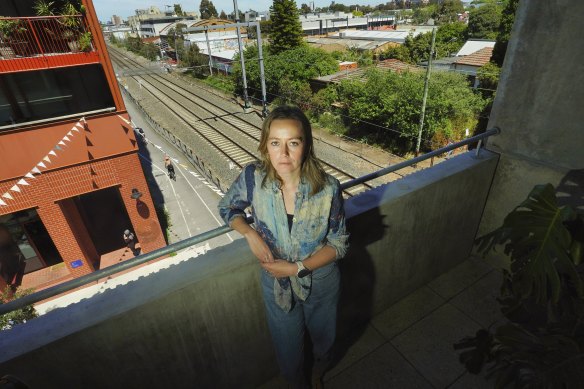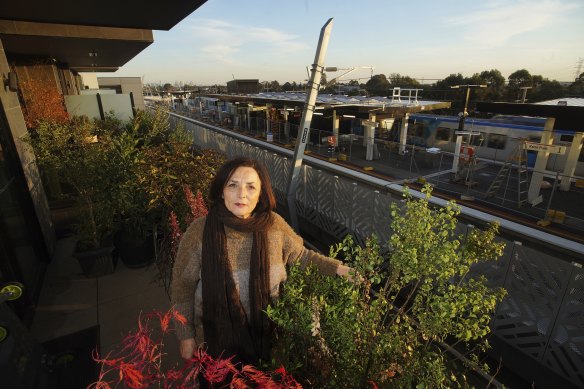Brunswick sky rail plans put station metres from apartment windows
Residents in a Brunswick development celebrated for its livability say they are “astonished” by plans to build an elevated train station just metres from some of their bedroom windows.
Brunswick, Anstey and Jewell stations will be shut and consolidated into two new stations when 2.1 kilometres of the Upfield Line is converted to sky rail between Albion Street and Park Street in Parkville by 2030.

Emma Chrisp, a resident of Brunswick’s Nightingale Village, says her apartment could become unlivable if an elevated train station is built within metres of her bedroom. Credit: Luis Ascui
But the plans announced by the Level Crossing Removal Project (LXRP) last month have sparked concerns over the location of the northern station along a narrow section of track between Hope and West streets.
Around 350 people live in Nightingale Village’s 203 apartments and the development has been praised as an example of the kind of high-quality, sustainable and medium-density developments that Victoria should strive to replicate as the state government tries to encourage more housing around 60 transport hubs.
Emma Chrisp bought her second-floor apartment off-the-plan and moved in two and a half years ago, but fears it will become unlivable if the station goes ahead as proposed.
The removal project has not released detailed designs for the new stations. However, based on the width of the train corridor and other sky rail station designs, the residents group Elevating Brunswick estimates that station platforms could be between one and five metres from Chrisp’s bedroom windows and balcony.
“None of us are opposed to elevated rail. But the station location relative to our apartments feels really challenging,” said Chrisp. Lights, noise from station announcements and loss of privacy are the top concerns.
The residents’ concerns have been heightened by the plight of those living in apartments near the new elevated Keon Park station in Reservoir, which opened earlier this year. Platforms are just four to five metres from apartment windows and residents say they are woken by train announcements.
Chrisp said she would likely investigate if a voluntary acquisition by the state government was possible, and estimated up to half of the residents in her building, who are mostly owner-occupiers, would do the same.
“The impact on the community would be massive,” she said. “I want to see a great outcome for the suburb. It could be this amazing thing and create new open space that Merri-bek really needs but it could be a huge missed opportunity.”
Geordie Barker, from Elevating Brunswick, which is made up of members living in 20 apartment buildings in the suburb, said residents were “astonished” by the proposed location of the northern station.
“It makes so little sense in terms of transport connections, in terms of access, in terms of the width of the [rail] corridor, that we didn’t even contemplate that it would be a possibility,” he said. “That’s how terrible and ill-thought-out out it is.”
Elevating Brunswick supports the sky rail project because it will create a significant amount of new open space, including an improved Upfield Bike Path and connect two sides of the suburb currently split by the train line.
But it is campaigning to have the station moved 180 metres south, on the other side of Hope Street, where there is a large vacant block on the eastern side of the tracks set to be developed into apartment buildings.

The issue facing residents around the Keon Park train station.Credit: Luis Enrique Ascui
Barker said a new station could be incorporated into the design of those apartments to create a station precinct, which would also have better connections to bus routes and minimise disruption to existing homes. Doing so would also preserve the popular Bulleke-bek Park, one of the few areas of green space locally.
“Through the consultation process… the LXRP have struggled to justify that station location outside of saying that it is more affordable for them,” Barker said.
Construction on Brunswick’s sky rail will start in 2029 and the project will remove eight level crossings at Albion, Hope, Victoria, Albert, Dawson, Union and Park streets, and Brunswick Road.
A project spokesperson said moving the station south of Hope Street would require additional property acquisitions, and also mean the two new stations would be only 600 metres apart, forcing some people to walk further to catch a train.
“Through extensive engineering and technical assessments, our expert team has determined the best-suited locations for the new stations,” the spokesperson said.
Start the day with a summary of the day’s most important and interesting stories, analysis and insights. Sign up for our Morning Edition newsletter.